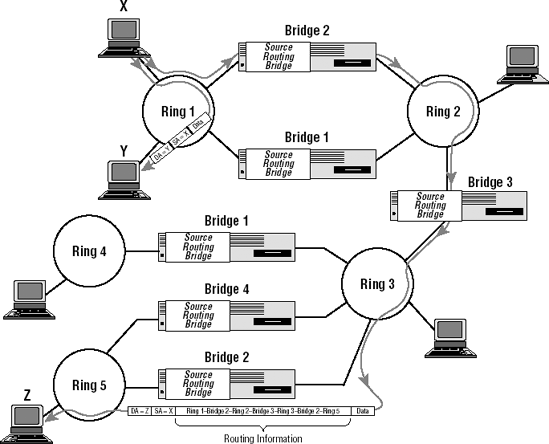6.1. Overview of Source Routing Operation
Consider the source-routed catenet depicted in Figure 6-1, and the communications among stations X, Y, and Z.
Figure 6.1. Source routing

Stations X and Y are on the same ring (ring 1). As a result, they can communicate directly without the use of source routing or any other type of bridge. Frames sent from station X to station Y carry a Destination Address of Y, a Source Address of X, and the data payload associated with the frame. Because the frame does not need to pass through any bridges, no source routing information is required.
Stations X and Z can only communicate through a series of intervening rings and bridges. Four different paths are available between these two stations:
Ring 1–bridge 1–ring 2–bridge 3–ring 3–bridge 4–ring 5.
Ring 1–bridge 1–ring 2–bridge 3–ring 3–bridge 2–ring 5.
Ring 1–bridge 2–ring 2–bridge 3–ring 3–bridge 4–ring 5.
Ring 1–bridge 2–ring 2–bridge 3–ring 3–bridge 2–ring 5.
Prior to communicating with station Z, station X (not the bridges) must learn the routes that are available using a Route Discovery process. Station X then selects one of the routes (in the example shown, station X has chosen the fourth route from the preceding list) and inserts the explicit list of intervening rings and bridges in all frames sent to station Z. That is, the frame itself is modified to include routing information that describes ...
Get The All-New Switch Book: The Complete Guide to LAN Switching Technology, Second Edition now with the O’Reilly learning platform.
O’Reilly members experience books, live events, courses curated by job role, and more from O’Reilly and nearly 200 top publishers.

